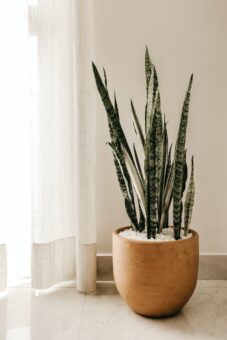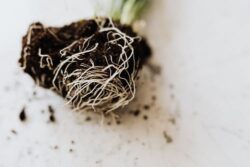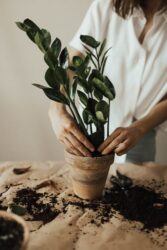In this article, we will be discussing the repotting of houseplants, it comes a time, even for slow-growing plants, where their roots become too big for the plant pot they have grown in. It is like a hermit crab that has outgrown its shell; time to look for a new home.

When you buy a houseplant, it comes already housed normally in a plastic container. A lot of people will grow the houseplant in this container for a while, whilst others may want to rehouse as soon as possible; the choice is yours. This can be bad for some plants as they hate root disturbance or because their roots have not gotten so big that they need to be rehoused.
Most plants grown in pots do their best if they are potted into containers that are only slightly larger than the existing roots system. If this root system continues to grow, it is only a matter of time before the roots have penetrated the new compost, as it reaches the inside of the pot.
Once the roots reach the confines of the pot, the roots are then forced to grow laterally between the compost and the pot. The result that their ability to take up both plant feed and water to become restricted. The overall result will be that the plant does not do well and we can now say that the plant has become root-bound.
WHAT ARE THE SYMPTOMS?
The first indication that a plant is becoming root bound is that the plant appears not to be growing or does so slowly, and more water seems to be required. This should warn you that something is not right with the plant. At this stage look at the base of the plant to see if any roots are poking through the drainage holes.
To confirm, the diagnosis of the plant of being pot bound by removing the plant from its container for examination. To do this, spread the fingers of one hand over the top of the compost and then invert the pot before gently tapping the bottom of the pot with your other hand. This should free the plant from the pot and allow the plant to be lifted away. It may come easily in one go or it may take some effort to prise the plant out
LOOK OUT FOR A MASS OF ROOTS

If there is a mass of roots on the surface then clearly your plant is searching for new food and water sources and the plant needs to be moved into a bigger pot. If however, no surface roots can be seen then the problem is of the plant not growing well is due to the root system.
To check this by carefully removing some of the compost where you suspect the problem lies, to see if any browned or blackened and dead roots can be seen. This is often a sign of root rot, caused by overwatering of the houseplant. The diseased areas should be removed by carefully cutting them off with a pair of scissors that have been disinfected before repotted in a clean pot of the same size using a fresh growing media. The container the plant was taken out of must be sterilized before the plant is repotted.
HOW TO REPOT?
The first thing you need to do is ensure that the root ball is moist but not waterlogged. In a clean pot bigger than the one the plant has come in, put a shallow layer of fresh moistened compost. The compost that you use must be suitable for the plant in question, so you can use houseplant, cacti, orchid, citrus or ericaceous.

The root ball is then placed on top of this layer and a check is made to see that the base of the plant stem is about 2cm below the top rim of the pot. If it is too shallow, you should add more compost to raise the plant up. If it is too high, then some compost needs to be taken away. Placing the compost too high will make watering difficult, as it will tend to overspill everywhere.
The plant can now be placed on top of the compost and any gap between the root ball and the pot should be filled with more compost, gently firming this either with your thumbs or by using a blunt stick.
WHEN TO REPOT?
The best time to repot is always in spring when active growth is beginning once more after the winter rest period. Some houseplant needs to be repotted annually, whilst others do not require this much frequency. Some plants require repotting once every two to three years.

It can get quite expensive rehousing houseplants as if you have many plants you will need a large number of pots. The advantage of this is that you can save them and use them when required to rehouse your houseplants at different stages of growth.
It is better to have a pot ready rather than going pot hunting in your garage or shed and finding out you do not have the right size.
Some plants do not like their roots to be disturbed and they can be left alone. Plants such as Aspidistra, Bromeliads, Peperomias, Sansevieria and Epiphyllum like it that way. They only have to be repotted once the roots are visible at the bottom of the pot and new growth has visibly slowed down.
CONCLUSIONS
In this article, we have discussed the importance of repotting your houseplants. This is important if you want your houseplants to start growing again and start performing. It is also a valuable way of checking the roots of the plants and dealing with any problems you may find, there and then.
In this article, we have also discovered when to repot and how to repot. It is suitable for all plants but must be done at different stages and years depending on what houseplant is being grown. Some houseplants need to be repotted annually, whilst others can be left for years to come.
Always check to see if the houseplant needs to be repotted and only do so when it is necessary.
If you have any questions or comments that you wish to make, please do so in the comment box below.
Do repot your houseplants but do get the timing right.

Thank you so much for sharing with us a beautiful and informative article. The main content of this article is about Repotting Houseplants. It is truly remarkable that you have presented this topic so well in your article. I have learned a lot by reading your article and gained a lot of knowledge about it. Of the points mentioned in your article, I like HOW TO REPOT. I have a few houseplants in my house and I REPOT the ones that are rootbound. However, in this case, with a little care, the house plants are mixed in a large container with different types of fertilizers.
Finally, I have read and enjoyed your article so the subject of the article is very important for those who make houseplants and would like to share it in my social media group if you allow me.
Hi Asraful
Thank you for stopping by and commenting, as I try to bring as much information to my readers in an understandable way so that they can apply it to the home or indoor garden. I am glad you have enjoyed the article and hope you apply it to your indoor garden.
Kind Regards
Antonio
Hello there! this is an amazing review you have got here, I am sure the information in this post will be of great help to anyone who come across it. I always repot often as it creates more room for plants to grow, more air getting to the root system and also prevent poor soil. Thanks for sharing this with me, I have learnt a lot from it!
Hi Joy
It is such a pleasure as I want to dispel the myth that replanting houseplants is difficult. It is not as long as you do it right and at the right time. I hope you got a lot out of it.
Thanks
Antonio
Well the only time I tried repotting, I misdid most of the planting again and I ended up killing a whole lot of my garden plants. Hence, I have actually been maintaining the idea of just keeping them to them. But what you have share here is really really great to see here. I value it and might consider it henceforth. Thumbs up
Hi Kimberley.
Thank you for the compliments, as it shows that I am doing something right. I am glad that the article has helped you to make sure that you are rehousing your houseplants correctly, as often losses can occur. Not so if you follow my guide.
Thanks
Antonio